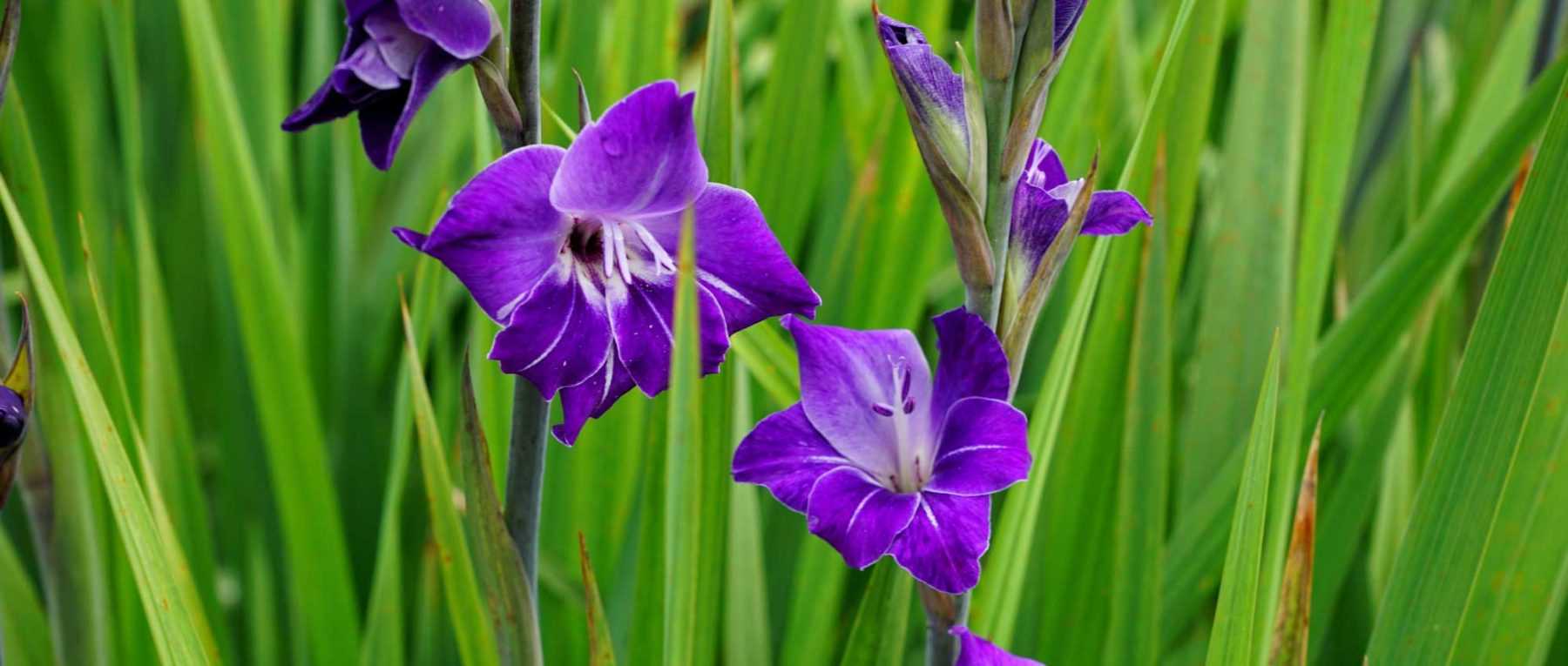
Gladioli: Planting, Growing and Caring
Contents
Gladioli in a few words
- Gladioli offer an exceptional diversity of colours
- Their hues are often vibrant and bright, but can also be soft
- They illuminate summer, bringing vitality to the garden!
- Their upright habit adds verticality and dynamism to flower beds
- They thrive in warm, sunny and bright locations
Our Expert's Word
The gladiolus is a bulbous plant that bears colourful spikes of large flowers in summer! These make excellent cut flowers and are frequently used in bouquets. Gladioli were very popular in the 1970s but have since fallen slightly out of favour… yet many varieties truly deserve our attention! Be charmed by the elegant blooms of Gladiolus callianthus (Abyssinian gladiolus or Acidanthera), the delicate pink flowers of Byzantine gladiolus, or the refined flowering of Gladiolus colvillei.
The gladiolus is a paradoxical plant: it can be exuberant and imposing, with vibrant, almost overwhelming colours… Yet at the same time, you’ll find species that are remarkably delicate, sometimes with truly elegant and natural-looking blooms. Gladioli surprise with their diversity: from the most extravagant varieties, perfect for highly designed flower beds, to wild gladioli like the Byzantine gladiolus, which can blend seamlessly into a cottage-style garden. As for colours, almost anything seems possible: red, white, green, yellow, even near-black gladioli… They’re generally tall plants that add volume to borders, though dwarf varieties also exist.
Gladioli are easy to grow. Plant them in spring for flowering a few months later. They thrive in full sun and well-drained, even sandy soils. For most varieties, maintenance mainly involves lifting the corms in autumn to store them frost-free over winter, then replanting in spring. Taller varieties will need staking.
Botany
Botanical data
- Latin name Gladiolus sp.
- Family Iridaceae
- Common name Gladiolus
- Flowering between June and October
- Height between 50 cm and 1.50 m
- Exposure full sun
- Soil type well-drained, fertile, light
- Hardiness generally -5°C, sometimes more
The gladiolus is a perennial plant with between 270 and 300 botanical species, and over 10,000 horticultural varieties. Most species originate from South Africa. Others grow in other regions of Africa, western Asia or around the Mediterranean. The centre of diversity for gladioli is the Cape Floristic Region in South Africa. In France, in the wild, there are 7 species, including Gladiolus italicus and Gladiolus byzantinus, two species sometimes introduced into gardens. Gladioli have been widely distributed by humans around the world for cultivation. Gladioli are divided into three main groups: grandiflorus, nanus and primulinus.
It was in the 18th century that gladioli originating from South Africa were imported into Europe for cultivation. Hybridisation began in the early 19th century. The horticultural varieties found in gardens today are derived from 6 or 7 South African species.
The gladiolus belongs to the Iridaceae family, like irises or crocuses! This family includes between 1,800 and 2,000 species, many of which are cultivated for their aesthetic appeal: crocosmia, chasmanthe, dierama, dietes, freesia, ixia, tritonia… These are monocotyledonous plants, often herbaceous, and usually with underground storage organs: bulbs, corms, rhizomes… Most often, their leaves are linear, thick, upright, and with parallel veins.
The name gladiolus comes from the Latin gladius, meaning sword, alluding to the shape of the foliage, which is thin, upright and pointed. It is a plant that symbolises strength and victory, heroism. In Roman times, gladiolus flowers were given to gladiators who won a fight.
Gladioli have an elegant, very slender shape. They add verticality and dynamism to the garden. They are generally quite tall; therefore, they are usually placed in the middle or back of borders to accompany smaller plants. The tallest varieties reach 1.50 m, even 1.80 m. Conversely, there are dwarf gladioli (Gladiolus nanus, Gladiolus colvillei, Gladiolus illyricus…), which do not exceed 50 cm in height.
Gladioli have a rigid, very upright appearance. Their stems are quite thick and are usually unbranched. Their lack of flexibility makes them quite sensitive to wind. This explains why the tallest varieties need staking.
Gladioli flower in summer, between June and September-October, for about 15 days, sometimes longer. The flowering period also depends on when you planted them, which is why it is advisable to stagger planting. Gladioli usually flower two and a half to three months after planting. There are also gladioli that flower in spring, such as Gladiolus byzantinus. Dwarf gladioli, Gladiolus nanus, usually flower in late spring, around June.
Gladioli produce long, very upright and rigid flower spikes. They are composed of densely grouped flowers, all on the same side of the flower stem. The spikes often bear between ten and twenty-five flowers – sometimes fewer in small gladioli (Gladiolus nanus, Gladiolus papilio, etc.). The flowers do not all open at the same time: those at the bottom open first, followed by those at the top.
Generally, gladiolus flowers are quite large. They have been selected specifically for their impressive flowering. Therefore, it is the large-flowered varieties (hybrids of Gladiolus grandiflorus) that are the most commercially available and most commonly cultivated. The flowers of botanical species and butterfly gladioli are smaller. Generally, gladiolus flowers are often between 2 and 5 cm in diameter.
They have a funnel or trumpet shape. They are sometimes elongated and not very open – the tepals forming a long, thin tube – as in Gladiolus italicus, but can also be wide open (Gladiolus callianthus). They are composed of smooth or wavy, curled petals. Some gladioli have thin, slender petals, very elegant, giving them a lily-like appearance, as in Gladiolus colvillei ‘The Bride’.


Gladioli offer diverse flowering! In order, Gladiolus ‘Priscilla’ (photo Pharaoh Hound), Gladiolus papilio ‘Ruby Free’, Gladiolus ‘Carl Lewis’, Gladiolus byzantinus, Gladiolus callianthus (photo Leonora Enking)
Gladiolus flowers consist of six tepals (three petals and three sepals, with the same appearance). There are two bracts at the base of each flower. The tepals form a tube at the base. The central tepal, located at the top, is often the largest. It surmounts three stamens. The three outer tepals are usually smaller. The flowers are bisexual: they have male (stamens) and female (pistil) organs. The stamens are sometimes decorative, as in Gladiolus colvillei ‘The Bride’, where they are purplish and add nuance to the immaculate white flowering. The gladiolus flower is of type 3: there are three sepals, three petals, three stamens, a style divided into three branches. And later, the capsules (fruit) will open into three parts.
While gladioli generally have a very rigid and imposing appearance, some species have much more delicate, lighter, more flexible forms, as is often the case with botanical gladioli, particularly Gladiolus carryophyllaceus, Gladiolus papilio or Gladiolus byzantinus.
Gladioli offer a very wide range of colours, as their flowers come in almost all shades, from the softest to the most vibrant! Some varieties are striking, while others are more pastel, delicate… And there are also gladioli with almost black dark red hues. But there are no true blue-flowered varieties.
The flowers can be plain, but are sometimes nuanced, with a lighter or darker throat. Butterfly gladioli usually have bicoloured flowers, with bright coloured spots, reminiscent of butterfly wings! Some varieties of Gladiolus nanus offer original flowering, white with three or four oval pink marks on the petals on one side of the flower (Gladiolus nanus ‘Impressive’ or ‘Nymph’). In Gladiolus primulinus ‘Atom’, the petals are red but edged with a fine white border.
Gladiolus flowers are very often used as cut flowers, for bouquets! They last well in a vase (about 15 days).
The acidanthera, or Gladiolus callianthus, is prized for its fragrance!
The gladiolus has upright, elongated, quite narrow leaves. They are sword-shaped, which gives the plant its name Gladiolus (from Gladius: sword). They measure between 20 and 60 cm in length. These are fairly characteristic leaves of the Iridaceae family. They have parallel, longitudinal veins, and are quite thick, leathery. The leaves emerge from the base and are arranged in a fan shape, sheathing.
Gladiolus leaves are green, sometimes slightly bluish.
The foliage is deciduous; it withers in autumn. It is important to leave it in place until it dries out naturally, as it plays an essential role in allowing the bulb to replenish its reserves. You can cut it once it is completely dry.
The gladiolus has underground organs often called “bulbs”, although they are actually corms. They are rounded and flattened, covered with a brown, fibrous tunic. This is the base of the stem which has swollen to accumulate nutrient reserves. The corm is depleted during flowering, then produces another corm, just above, which replaces the old one. The largest bulbs guarantee the most beautiful flowering, the largest flowers. This is why we advise you to preferably choose bulbs of large size, at least 12 or 14. Around the corm, the gladiolus produces small bulbils, or cormlets, which can be detached and replanted elsewhere to propagate the plant… but they need several years to grow and be able to produce flowers.
The butterfly gladiolus, Gladiolus papilio, has underground stolons that allow it to spread.
The fruit of the gladiolus is a capsule containing numerous brown, winged seeds (except for Gladiolus italicus, which has smooth seeds). When the capsules are ripe, they open into three parts.


The fruit of Gladiolus communis (photo Meneerke bloem) / The ripe fruit of Gladiolus italicus (photo Meneerke bloem) / The fruits and seeds of Gladiolus illyricus (photo Roger Culos – Museum Toulouse)
The gladiolus is not a completely hardy plant. It is best to dig up its corm in autumn to store it in a frost-free shelter. However, there are a few relatively hardy species: Gladiolus italicus, Gladiolus byzantinus, Gladiolus papilio…
The main varieties
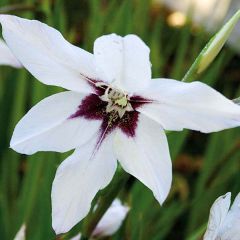
Gladiolus callianthus - Abyssinian gladiolus
- Flowering time September to November
- Height at maturity 60 cm
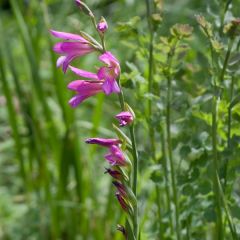
Gladiolus italicus - Italian Gladiolus
- Flowering time May to August
- Height at maturity 60 cm
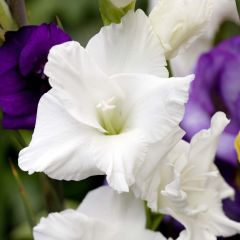
Gladiolus White Prosperity - Sword Lily
- Flowering time August to October
- Height at maturity 1,20 m

Gladiolus primulinus Atom - Sword Lily
- Flowering time July to October
- Height at maturity 60 cm

Gladiolus The Bride - Sword Lily
- Flowering time July
- Height at maturity 45 cm
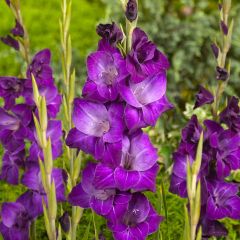
Gladiolus Violetta - Sword Lily
- Flowering time August to October
- Height at maturity 1 m

Gladiolus Robinetta - Sword Lily
- Flowering time August, September
- Height at maturity 50 cm
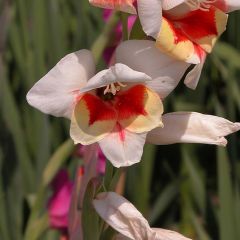
Gladiolus Lorena - Sword Lily
- Flowering time August to October
- Height at maturity 1 m
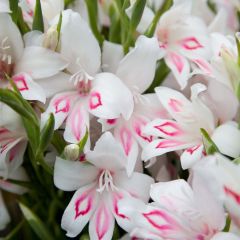
Gladiolus Nymph - Sword Lily
- Flowering time July, August
- Height at maturity 50 cm
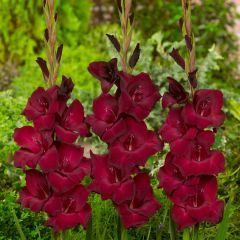
Gladiolus Espresso - Sword Lily
- Flowering time July to September
- Height at maturity 1,20 m
Discover other Gladioli
Planting Gladioli
Where to Plant?
Plant gladioli in full sun to ensure a beautiful flowering display. They bloom less profusely when planted in shade. In gardens in southern France, they can however be planted in partial shade, provided there is sufficient light.
Gladioli dislike waterlogged soil in winter, as the corms may rot: this is why it is important to grow them in a light, well-draining substrate. If your soil is clay-heavy and compact, improve it by adding coarse sand or gravel. Gladioli thrive in sandy soils. The Marsh Gladiolus, Gladiolus palustris, is an exception, as it prefers moist soil.
Gladioli appreciate fertile soil, rich in organic matter. We recommend adding well-rotted compost. Avoid fertilising with manure, however, as this may cause the corms to rot.
Choose a sheltered spot protected from wind, as strong winds can damage the tall flower spikes. If exposed to wind, staking will be necessary.
Gladioli are susceptible to several fungal diseases: to minimise the risk of infection, avoid replanting the bulbs in the same spot year after year.
When to Plant?
Gladioli are planted in spring, from April until May-June. In mild climates, they can even be planted from March, while in colder regions it’s best to wait until May. You can stagger planting by setting bulbs every two weeks.
Some species are planted in autumn, around September-October. This applies to Gladiolus byzantinus and certain spring-flowering gladioli.
How to Plant Gladioli?
For the best effect, it’s preferable to plant gladioli in groups of at least 7 to 10 plants. You can also scatter them in a flowerbed for a more natural look. They are sometimes planted in rows, particularly when grown for cut flowers. In any case, space each corm about 15 cm apart. You can use a bulb planter.
When purchasing gladioli, we recommend choosing corms with a size of at least 12. Their flowers will be more impressive.
- Prepare the soil by loosening it, removing weeds, large stones, and breaking up clumps. Optionally, add some well-rotted compost.
- Dig a hole. If your soil is heavy, you can add some coarse sand at the bottom for drainage.
- Place the corm the right way up (with the pointed end facing upwards). Plant it about 10 cm deep.
- We recommend placing a stake next to each bulb to support them once they grow tall. This will also help you remember their location and avoid damaging the corms if you need to replant in the same bed later.
- Cover the bulbs with soil and firm down.
- Water lightly if the weather is dry.
Gladioli will flower two to three months later.
Also check out our guide on planting gladioli! and 5 gladioli for pots

Planting gladioli (photos Wouter Koppen – iBulb)
Read also
Planting GladioliMaintenance
Water regularly during summer and throughout the flowering period. Water at the base to avoid wetting the foliage, as gladioli are susceptible to several fungal diseases encouraged by moisture. You can apply a layer of mulch to keep the soil cool and prevent weeds from growing. Avoid watering when the plant is dormant or just beginning to grow. Wait until it has several leaves before starting to water. Gladioli dislike waterlogged conditions, as this can cause the corms to rot.
You can take advantage of watering to add a little liquid fertiliser, particularly in spring, possibly using a ‘bulb-specific’ fertiliser. Avoid using manure, as this may cause the bulbs to rot.
When gladioli start gaining height, you can install discreet staking to support the flower spikes of taller varieties, especially if they are exposed to wind.
We recommend regularly removing faded flowers and cutting the flower spikes once all blooms have withered.
In any case, do not cut back the foliage until it has completely died back. It allows the plant to replenish its reserves, storing nutrients in the corm before entering dormancy so it can flower again the following year.
Feel free to pick the flowers for bouquets! But in this case, cut while leaving the leaves in place, as they are essential for the corm to rebuild its reserves and bloom again the next year. Let them wither and dry naturally.
Storing Gladiolus Corms in Winter
If you live in a cold climate where temperatures frequently drop below -10°C, you will need to dig up the bulbs in autumn to protect them from frost:
- Wait until the foliage has turned yellow and dried, then dig up the corms, taking care not to damage them.
- You can sort them and keep only the largest ones (these produce the most beautiful flowers!).
- Clean them by removing soil, cut off the stem and leaves. Do not remove the corm’s outer layer.
- Dry them by placing them in a warm, well-ventilated spot for several days.
- Once dried, you can remove the old bulb located just beneath the new one each time.
- Arrange them in a tray on a layer of sand or sawdust, ensuring they do not touch.
- Store them in a dark, dry, well-ventilated, and cool place (between 2 and 10°C).
- You can replant them in spring.
Beware of rodents and mould during winter!
If you live in a mild climate, feel free to leave the bulbs in the ground! Similarly, some gladioli are much hardier than others (Gladiolus papilio, Gladiolus nanus…). They can overwinter in the ground. However, gladioli left in place for several years will become less floriferous over time, as they produce bulbils each year that initially only produce leaves! It’s best to refresh the clumps occasionally.
Discover our advice sheet: Dividing, Overwintering and Propagating Gladioli
Diseases and Pests of Gladiolus
Gladioli are susceptible to botrytis, a fungal disease noticeable by the presence of a fuzzy mould.
They can be affected by septoria leaf spot (small brown spots on the leaves) and fusarium wilt (leaves dry out and turn yellow). Gladioli may also be affected by rust. To reduce the risk of disease transmission, avoid replanting gladioli in the same spot year after year (ideally, wait at least four years before planting them there again). These diseases are also encouraged by moisture: grow your gladioli in well-draining soil, avoid overwatering, and take care not to wet the foliage when watering.
Gladioli are sometimes attacked by aphids, which pierce the leaves and suck the plant’s sap. Treat with black soap to eliminate them. Slugs may also nibble on the leaves—you can use ferramol or set up a slug trap. Thrips are another issue for gladioli cultivation, causing discoloured spots on flowers or leaves. They can lead to flower deformities or prevent blooms from opening. Gladioli may also be attacked by the gladiolus thrips, an insect that bores holes in leaves and flower buds.
When stored, the bulbs are prone to rotting. It’s essential to monitor humidity levels and keep them in proper conditions. When planted in the ground, the same issue applies—vigilance is needed to prevent excess moisture and bulb rot.
Gladiolus Propagation: Division and Seed Sowing
Gladioli are mainly propagated by separating the corms. They can also be grown from seed, but division remains the simplest and quickest method!
Dividing Gladioli
Gladiolus bulbs produce cormlets (or bulbils) around the main bulb. These are small white spheres attached to the base of the bulb. You can easily detach them from the original bulb to obtain new plants. The best time to do this is in autumn (once the foliage has dried), around early November, while you dig up the bulbs to store them frost-free for winter.
- Dig up gladiolus bulbs in autumn.
- Remove the bulbils around the original bulb. Choose the largest ones.
- Store them over winter in a crate filled with sand.
- Replant them the following spring, in April-May.
The bulbils will take two or three years before they start flowering.
Sowing Gladiolus Seeds
Growing gladioli from seed can be tricky… Separating corms is much easier and faster! However, if you wish to propagate them by seed, it’s best to sow in early spring.
- Take a pot and fill it with fine, sieved compost. Lightly firm the soil and moisten the substrate.
- Sow the seeds by scattering them on the surface.
- Cover them with 1 to 2 centimetres of compost.
- Water gently with a fine spray.
Place the pot in a bright location at around 15°C. Keep the substrate slightly moist until germination. It will take several years before the gladioli begin to flower.
Pairing Gladioli in the Garden
Gladioli integrate beautifully into flower beds or colourful mixed borders! Position them towards the back, behind lower-growing plants. Pair them with other sun-loving summer bloomers: dahlias, crocosmias, rudbeckias, nasturtiums… Gladioli complement other show-stopping blooms with large, colourful, majestic flowers like lilies or dahlias… Plus, you’ll create perfect cutting garden displays!
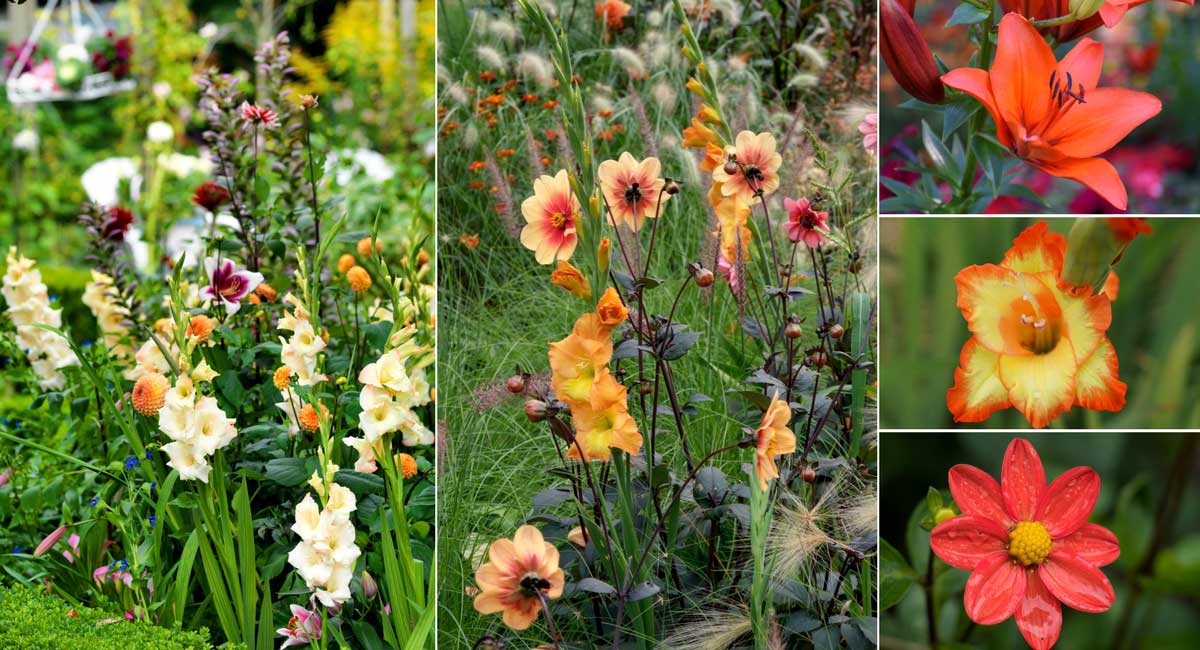

A combination with gladioli, dahlias and lilies (photo Steven Bemelman – iBulb) / Association of dahlias, gladioli and pennisetum (photo Maayke de Ridder – iBulb) / Lily / Gladiolus ‘Princess Margaret Rose’ / Dahlia ‘Inflammation’ (photo F.D. Richards)
Available in an exceptionally wide colour palette with infinite shades, gladioli are perfect for creating stunning contrasts or harmonious tonal pairings! They pair effortlessly with dahlias, which also offer an extensive colour range… You’ll easily find complementary hues!
Their rigid, upright habit means we recommend planting gladioli alongside more relaxed, airy plants: ornamental grasses, cosmos, sanguisorba, gaura, Verbena bonariensis… These add lightness and softness! Alternatively, scatter gladioli among lower-growing plants – their tall flower spikes bring verticality, dynamism and structure.
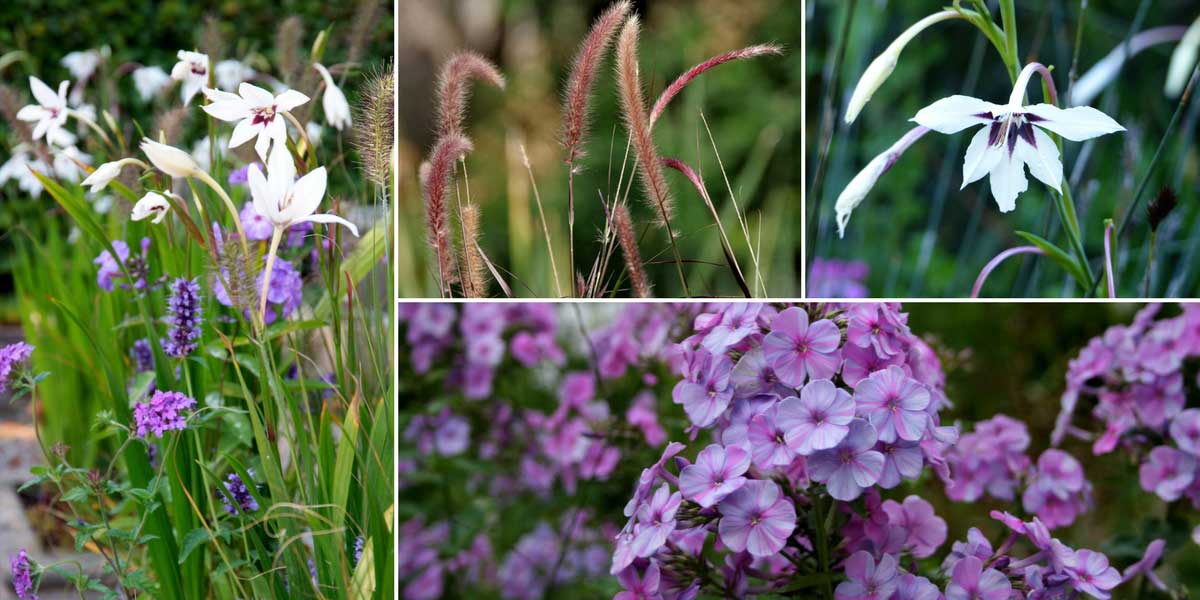

A combination of Gladiolus callianthus, agastache, phlox, verbena, pennisetum (photo Maayke de Ridder – iBulb) / Pennisetum setaceum / Gladiolus callianthus (acidanthera) / Phlox ‘Lilac Time’ (photo Uleli)
Though often perceived as rigid plants with flamboyant blooms, some gladioli varieties are far more delicate and natural-looking, making them ideal for wild or cottage gardens. Opt for botanical gladioli: Gladiolus byzantinus, Gladiolus callianthus, Gladiolus illyricus… Plant them alongside clumps of pennisetum and stipa, plus verbena, Gaura lindheimeri or agastache.
Further reading for inspiration: Gladioli: 5 Successful Planting Combinations
Useful resources
- Discover our range of gladioli!
- Advice sheet – Dividing, overwintering and propagating gladioli
- Advice sheet – Planting gladioli
- An article by Ingrid on our blog – In defence of gladioli and ideas for rehabilitating them
- An article on our blog – Bulbs, corms, rhizomes… What’s the difference?
- Advice sheet: Bulb sizing: understanding to choose better
- Our 2022 new varieties of gladioli and dahlia bulbs!
- Gladioli in every colour! : 7 white-flowered gladioli; 7 pink-flowered gladioli; 7 multicoloured gladioli;
- Discover 7 exceptionally flowering gladioli to brighten up your garden
- Discover our selection of the hardiest gladioli
- Advice sheet: Our secrets for having gladioli in bloom all summer
Frequently asked questions
-
My gladiolus isn't flowering! What should I do?
This issue may stem from a location that's too shady or too cold... Gladioli need warmth and full sun to flower properly! Alternatively, if you obtained them by separating the bulbils (from around the edge of an original bulb), these require several years before flowering. The bulb needs to grow large enough and store sufficient reserves to bloom. Check that the growing conditions suit them (sunny spot, well-draining and fertile soil...)!
-
The flowers of my gladiolus have silvery white spots!
These are thrips, small insects that pierce plant tissues to feed, causing discoloured spots to appear on leaves or flowers. We recommend treating them with a mixture of black soap and garlic decoction. Thrips dislike humidity; you can also mist the foliage during dry weather, but beware of fungal diseases (which are encouraged by moisture).
- Subscribe!
- Contents



































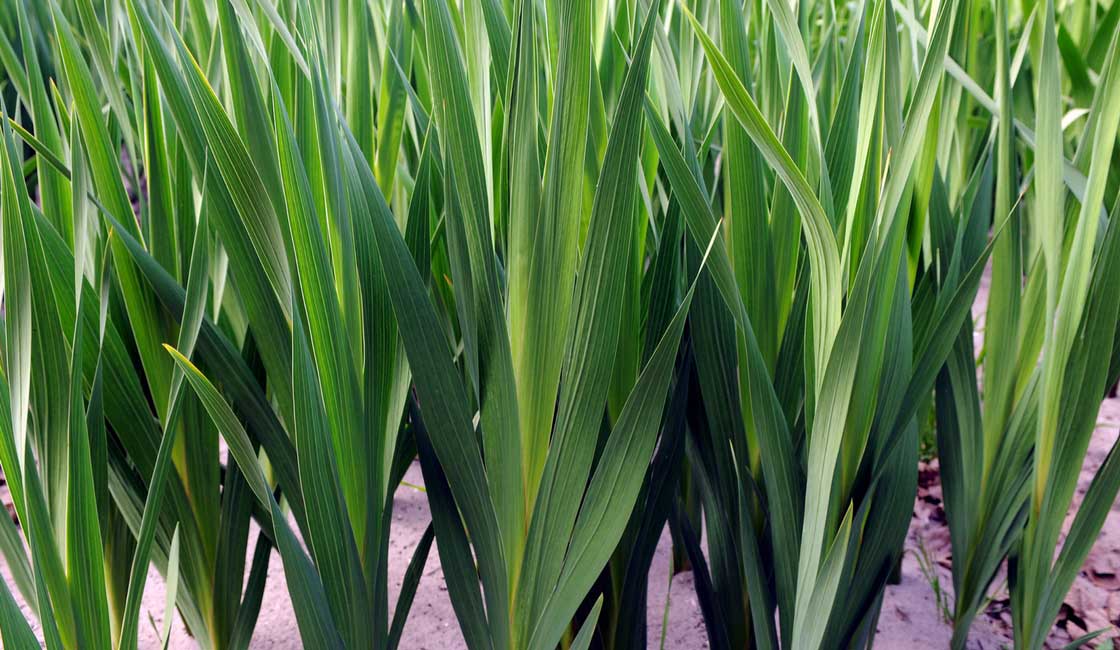

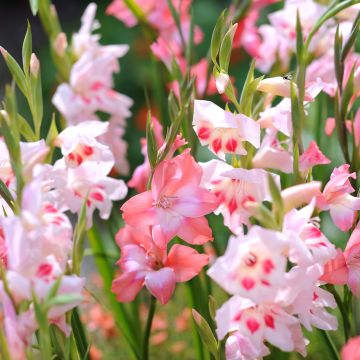

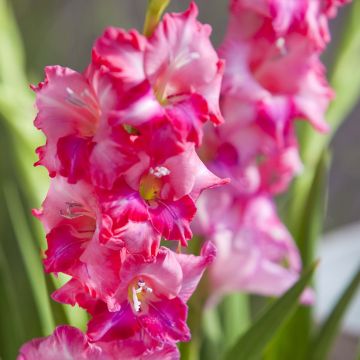

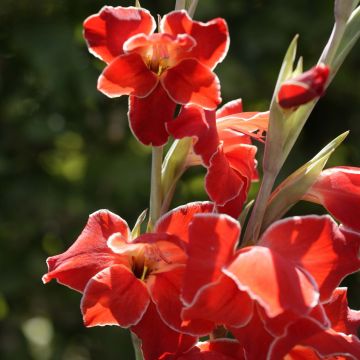

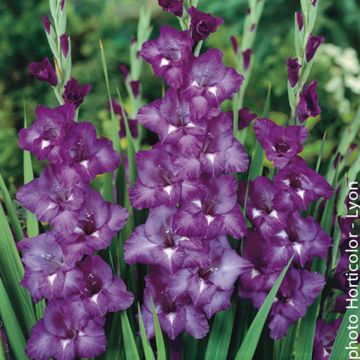
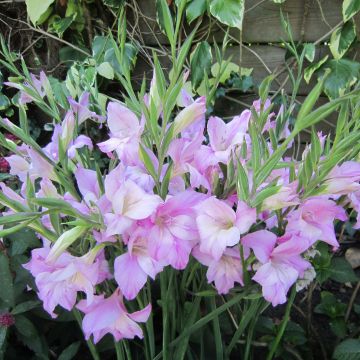

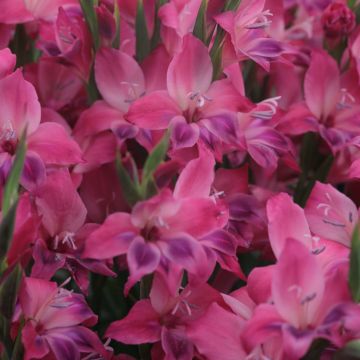
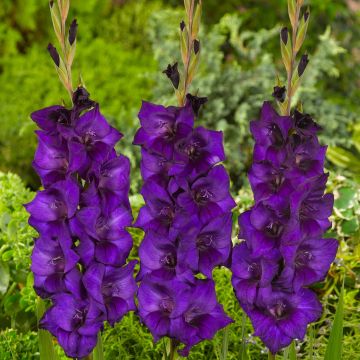


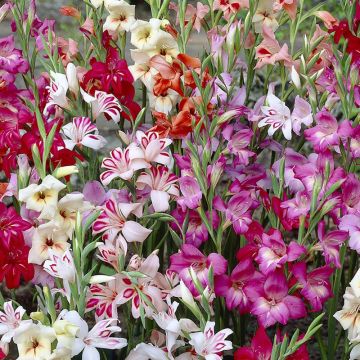
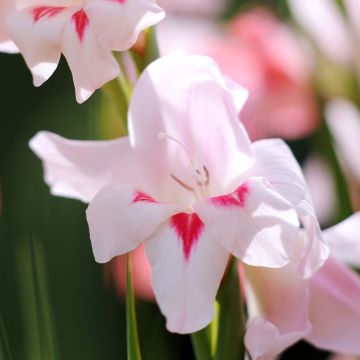
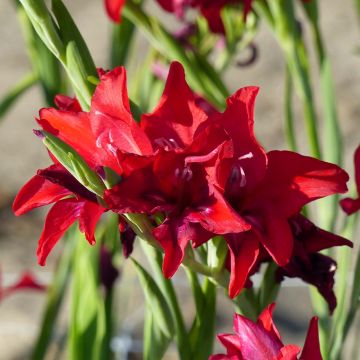
Comments